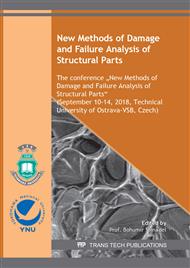p.46
p.52
p.58
p.64
p.70
p.76
p.82
p.89
p.95
Comparison of Behaviour of Different Variants of Hydrogenated TRIP Steels at Slow Strain Rate Tests
Abstract:
The paper describes effect of hydrogen on mechanical properties and fracture characteristics of two types of C-Mn-Si TRIP steel; laboratory prepared steel TRIP 800 and commercially manufactured steel TRIP 780. TRIP steels are very promising materials thanks to their combination of a very good strength and toughness. However, these steels can be embrittled by hydrogen during technological operations related to galvanizing. That is why the knowledge of effects of hydrogen on the properties and fracture characteristics of the TRIP steels is of particular importance. In the presented study, effects of hydrogen were studied by tensile tests after electrolytical hydrogen charging. Electrolytical hydrogen charging was performed in 0.05 M solution of sulfuric acid with addition of potassium thiocyanate to promote hydrogen absorption. Hydrogen provoked embrittlement in both steel variants and changed their fracture micromechanism. Hydrogen embrittlement manifested itself mainly by a loss of plasticity. Index of hydrogen embrittlement, expressed on the basic of a relative drop of elongation to fracture, reached values about 77 % for the steel variant TRIP 800, resp. 83 % for the steel variant TRIP 780. No significant difference was observed between two steel variants studied. Concerning fractographic characteristics, steels containing hydrogen displayed quasi-cleavage fracture mostly on the edges of the sample and around elongated non-metallic inclusions.
Info:
Periodical:
Pages:
70-75
Citation:
Online since:
July 2019
Authors:
Price:
Сopyright:
© 2019 Trans Tech Publications Ltd. All Rights Reserved
Share:
Citation:


